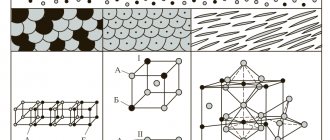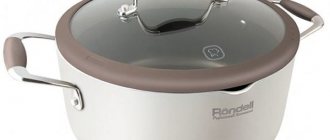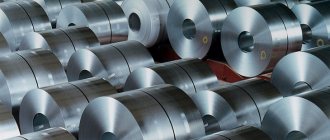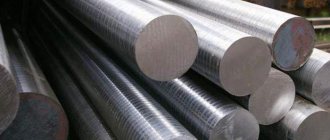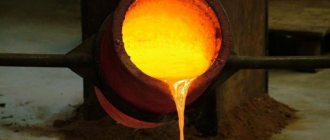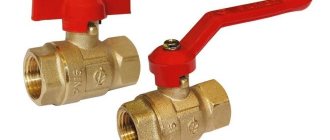Bronze is an alloy of copper with tin, aluminum, lead, silicon and beryllium. The composition of the alloy can include a variety of metals, the names of which give the name: tin bronze, aluminum. The percentage of impurities should not exceed 2.5%. The exceptions are nickel and zinc - copper alloys with these elements are called cupronickel and brass, respectively. However, a small amount of zinc may still be present in the composition - its amount must be lower than the sum of all other impurities, otherwise the alloy will be considered brass.
The name itself comes from the Italian “bronzo”. The alloy was first used in the 35-33rd century BC . (exact dates have not been established) when the Bronze Age began, which replaced the Copper Age. Thanks to improved processing of copper and tin, it was possible to obtain a fairly durable and beautiful alloy, which lasted almost until the 11th century BC. It was used for the production of arrow and spear tips, daggers, knives, swords and other bladed weapons, for the production of furniture parts, mirrors, dishes, vases, jugs, jewelry, statues and coins.
In the Middle Ages, bronze was used to make church bells and cannons; the latter were made from special gun bronze until the 19th century.
History of bronze
Thanks to improvements in the processing of metals such as copper and tin, in 3000 BC. The Bronze Age began. It is characterized by the active production of an alloy such as bronze, which was used for the manufacture of tools and jewelry.
In the modern metallurgical industry, in addition to copper and tin, materials such as aluminum, phosphorus, lead, and zinc are also used. The name itself comes from the Persian word “berenj”, which translates as “copper”.
It is known that the first bronze was made from Cu and arsenic and was called arsenic. However, due to its toxicity, it was very quickly replaced by tin. It is not surprising that blacksmiths were often depicted as ugly and disfigured. In fact, this is what happened. Prolonged contact with arsenic had a very bad effect on their body. For this reason, the alloy of copper and tin is called bronze, since these are the components most often present in it.
Application
Bronze is intensively used in industry and in a wide variety of fields. First, bronze is used in rolled products of the same name: it is produced in the form of pipes, wire, sheets and rods. The alloy can also be found in the automotive, chemical, food, construction and fuel industries. It is used to create gears, bearings, bushings, springs and other parts that are exposed to a brutal environment and often operate at high pressure. Unlike brass, bronze tolerates mechanical overloads and is the most ductile.
The alloy is used to create objects of art, statues, forged items, decorations, dishes and artistic objects.
Characteristics of bronze
We all know that a metal like copper is very soft, ductile and absolutely fragile. At the same time, it has very high electrical and thermal conductivity. An alloy of tin and copper is a material that significantly exceeds the characteristics of these chemical elements individually. In other words, bronze has high hardness and strength, but at the same time it is quite fusible.
The discovery of this alloy played a major role in the metallurgical industry. Although many other materials were invented later, even today it is very popular due to its good mechanical properties.
Physico-chemical characteristics of copper
In its natural environment (in the air), copper has a striking yellow-red color. This color is assigned to the alloy by the oxide film formed on its surface. A pure alloy is a fairly soft material; it is simply rolled and drawn. But the introduction of certain impurities during its production makes it possible to increase its hardness and change other characteristics.
The density of this material is 8890 kg/m3, the melting point is within 1100 °C.
The main property that determined its applicability in everyday life and production. In addition to the highest electrical conductivity, copper is characterized by the highest thermal conductivity. The introduction of such impurities as iron, tin and some others have a significant impact on its characteristics.
Apart from the named characteristics, copper has the highest melting and boiling points. Copper has the highest resistance to corrosion.
The physical characteristics of copper make it possible to obtain various products from it, for example, wire several microns wide.
Copper and its compounds found their application, first, in the electrical industry; in general, no matter what other area of the industry can hardly do without it.
Bronze's ability to resist corrosion
One of the most important properties of the alloy is its corrosion resistance. This is especially true for those compositions that contain a significant content of manganese and silicon (more than 2%).
It was found that high corrosion resistance manifests itself upon contact of bronze with water (sea and fresh), concentrated alkalis and acids, sulfates and chlorides of light metals, as well as upon contact with dry gases (tin-free bronze).
Of course, in general, the corrosion properties of the alloy depend on the alloying elements. Thus, a high lead content reduces the ability to resist corrosion, while nickel increases this property.
Marking
To choose the right metal option, just look carefully at its markings.
This will help to accurately determine the features and characteristics of the selected species. The letters “Br” come first - this means “Bronze”. Then one or more letters are located in a row, behind which additives are hidden: O - Tin, A - Aluminum, K - Silicon, N - Nickel, Mts - Manganese, F - Iron, S - Lead, F - Phosphorus, C - Zinc, B - Beryllium. Next, numbers are written through a hyphen - this is the percentage of each additive in turn.
For example, the designation Br A ZH N -10 -4 -5 can be deciphered as follows: Bronze containing Aluminum (10%), Iron (4%) and Nickel (4%).
Types of bronze
Alloying elements that may be present in this alloy can significantly change its properties, and the type of bronze depends on them. In addition, tin can be replaced by other elements. For example, BrAMTS-7-1 can be deciphered as follows: 92% copper, 7% aluminum, 1% manganese. This grade of bronze does not contain tin and, due to this, has high resistance to alternating loads. It is used for the manufacture of bolts, screws, nuts and parts for hydraulic installations.
Another example is tin cast bronze of the BrO10S10 grade. It contains up to 83% copper, 9% tin, 8% lead and up to 0.1% iron, silicon, phosphorus and aluminum. It is intended for parts that operate under conditions of high specific pressures, for example, for plain bearings.
Although bronze is an alloy of tin and copper, in some cases the chemical element Sn is not used. Another example of tin-free bronze is heat-resistant. For its manufacture, only 98-99% copper and 1-2% cadmium are used. An example would be the BrKd1 brand. This is a heat-resistant cadmium bronze with high heat resistance and electrical conductivity. It can be used for the manufacture of parts for resistance welding machines, electric motor commutators and other parts operating at high temperatures and requiring good electrical conductivity.
Another type of alloy used to make gaskets in automobile bearings and bushings is pressure-processed tin bronze. The alloy of copper and tin contains alloying elements such as lead (4%), zinc (4%), aluminum (0.002%), iron (0.005%). The steel grade is called BrOTsS4-4-4. It is thanks to the percentage of these chemical elements that this alloy can be processed by pressure and cutting. The color of bronze also depends on impurities. So, the less copper the alloy contains, the less pronounced the color: more than 90% is red, up to 80% is yellow, less than 35% is steel gray.
Features of bronze and properties
The main properties of all bronze alloys are ductility and hardness. Depending on the ratio of the main and additional components, a wide variety of new properties can be obtained. In addition, the amount of copper in the alloy determines its color.
So, golden bronze will be obtained if the alloy contains about 85% copper, and if its amount is reduced to 50%, an alloy will be obtained that has a silvery color. Reducing the amount of copper to 35% and below will lead to the output of gray and even black bronze, and increasing the amount of copper to 90% and above will lead to the formation of red bronze.
One of the old brands of bronze alloys is bell bronze , which is still used today for casting bells. It contains 20% tin and 80% copper. Its disadvantage is increased fragility due to the high tin content in the alloy.
As mentioned above, the most commonly used are alloys of copper and tin with the addition of a small amount of other components. The widespread use of such alloys is due, first of all, to historical reasons that led to the displacement of arsenic bronze from production.
Such reasons are the following:
- the development over many centuries of deposits of tennantite and other faded ores rich in copper and arsenic. Such ores were most convenient for the production of arsenic bronze, since they did not lie very deep, which made the production process cheaper compared to other sources of copper and arsenic;
- the high toxicity of the production of such bronze, caused by the presence of arsenic in the deposits, which inevitably led to loss of health and further ability to work for experienced metallurgists and blacksmiths;
- unsuitability of metallurgical defects and broken products made of arsenic bronze for further remelting into high-quality metal. At best, such products were used to make jewelry or non-essential parts.
The alloys of copper and tin that replaced arsenic bronzes, although they were more expensive to produce, were economically preferable , since the development of horse-drawn transport and the resulting establishment of trade relations between cities and countries led to an increase in the import of non-arsenic bronze.
Types of bronze and characteristics
The development of large-scale industrial production generally led to the fact that tin bronzes became almost the most widespread type of bronze. And only in the last hundred years this type began to be replaced by copper alloys with tin substitutes, such as aluminum, silicon and, especially, beryllium bronzes.
Thus, the following types exist:
- tin-free. It includes bronze, in which the second components are aluminum, silicon, beryllium and other metals and non-metals. Each of these components gives it special properties. For example, aluminum gives the alloy increased anti-friction properties and high corrosion resistance, beryllium increases strength and hardness, and silicon and zinc improve its fluidity and abrasion resistance;
- tin. A copper-tin alloy in which copper predominates. It is one of the first to be mastered by man. It has high hardness and strength compared to pure copper, and is also more fusible. In such alloys, tin is always the second most abundant after copper and the main alloying component.
The third in quantity are additional components such as arsenic, zinc and lead . Due to its very low shrinkage, this metal is mainly intended for casting, as it is difficult to work with pressure, cutting and sharpening. Even the tendency to segregation and low fluidity do not prevent the use of this alloy for the manufacture of configurationally complex castings, including in artistic casting.
Bronze with the addition of zinc is called “Admiralty ” and is used for the manufacture of parts that have frequent or constant contact with sea water (shipbuilding). This feature is due to the fact that zinc gives the alloy increased corrosion resistance in the specified environment.
However, to make bronze resistant to corrosion in salty seawater, it is increasingly being enriched with aluminum and nickel . Such alloys, often called “marine”, are used to manufacture elements of oil platforms operating on sea and ocean shelves.
To give bronze additional characteristics, of phosphorus, silver, zinc, arsenic, manganese and other components are alloyed into it Thus, adding a small amount of silver increases the electrical conductivity of bronze and makes it comparable to the electrical conductivity of copper.
Bronze processing
As mentioned earlier, an alloy of tin and copper is a fairly durable material. It is difficult to sharpen, cut and press. In general, this is a casting material with low shrinkage - about one percent. And even despite its low fluidity and tendency to segregation, bronze is used for the manufacture of castings with complex configurations. Art casting is no exception.
Alloying elements that are added to the tin-copper alloy improve its properties and reduce its price. For example, alloying with lead and phosphorus improves the processing of bronze, and zinc increases its corrosion resistance. For certain purposes, deformed alloys are made. They easily change their appearance using cold forging.
physical characteristics
The physical characteristics of the alloy depend on its composition and can vary significantly. Unlike brass, bronze has the highest anti-corrosion resistance and anti-friction properties. It is the most highly durable and has strong resistance to air, water, salt, and organic acids. Bronze is also easy to solder and weld .
- Density: 7800-8700 kg/m3.
- Melting point: 930С – 1140С.
- The color ranges from reddish to snow-white.
- It has high wear resistance and a low coefficient of friction, and copes even at low temperatures down to -250С.
- Some types of bronze have higher vapor resistance, thermal conductivity and electrical conductivity and are used in technology operating under heavy conditions.
Application area
Of course, the use of bronze does not lose its popularity in our time. Souvenir products, decorative interior items, decorations for gates and gates... In addition, the alloy is used for the manufacture of fittings (handles, hinges, locks) and plumbing fixtures (taps, fittings, gaskets, faucets). Bronze also has wide range of uses in industrial applications. Thus, cast alloy is used for the manufacture of bearings, sealing rings, and bushings.
The widespread use of bronze is particularly influenced by its corrosion properties. For this reason, it is used to make parts of mechanisms that operate in constant contact with water. The high elasticity of the alloy makes it possible to make springs and parts of control and measuring equipment from it.
Application of alloys
Bronze and brass are used in all industries, first in the electrical industry.
Interesting read: How to bend a copper tube at home
In the production of pipeline fittings, for example, in the production of valves, valves, etc. In addition, copper alloys are used in the development of heating, ventilation and air conditioning systems.
Bronze is used in the production of antifriction products, for example, those installed in plain bearings.
Copper alloys can work in harsh environments, for example, in sea water, watery fuel, etc.
Bronze also plays an important role in decorating the interiors of buildings and structures. Namely, tin bronzes were used in the old world to create objects of art and luxury. Manufacturers put on the market a wide range of products made from brass and bronze.
Figures made of bronze and brass
So, on the market you can buy pipes that are obtained by the cold deformation method. They come in 3 states - soft, semi-hard, hard. Sheets and strips are produced using cold rolling. With all this, the sheets have the following dimensions of 600-3000X1000-6000 mm. Depending on the condition of the material, cold-rolled sheets and strips are produced as soft, semi-hard and hard.
For the production of wire, brass grades L63 or L68 are used. They are supplied either in the form of rods up to 6 m long, or rolled into coils up to 10 m long.
Rods of various diameters and lengths of up to 6 meters are created from the bronze alloy BrAZhMts.
Bronze remelting
Of course, each alloy has both its pros and cons. Bronze is an alloy that consists of copper and tin, and therefore it withstands any melting. It can be used several times for completely different purposes. On the other hand, if bronze contains a large amount of impurities, such as magnesium, silicon, aluminum, then during remelting the mechanical properties may decrease.
This is due to the fact that alloying elements that improve the characteristics of bronze are oxidized during melting and form refractory oxides, which are located along the boundaries of the crystal lattice. They break the bond between grains, which makes bronze more brittle.
Receipt
Bronze is made by fusing copper with various metals to enhance certain characteristics. For this purpose, induction furnaces and crucible forges , suitable for melting any copper alloys. Melting is usually carried out under a layer of charcoal or flux. For smelting, either fresh ore that has not yet been processed or secondary waste can be used. The latter are usually added to fresh copper during the smelting process.
When using only fresh ore, the following order is observed: coal or flux is placed in a preheated furnace, copper is loaded and heated until it melts - 1150Co - 1170Co. Then the metal is oxidized by adding copper phosphorous, sometimes it is introduced in several stages - 50% immediately, 50% in a ladle. After deoxidation, additional additives are introduced, heated to 100Co - 120Co .
If additional metals are refractory, then they are first completely dissolved in liquid copper and then heated to a certain temperature. Having pulled the alloy out of the furnace, it is deoxidized by introducing 50% phosphorous copper to get rid of oxides.
If secondary metals or waste are used, then pure copper is first melted, deoxidized with phosphorous copper and secondary metals are added. After melting the latter, additives are introduced into the liquid copper and wait until they melt. After heating to a certain temperature, the alloy is deoxidized with phosphorous copper and covered with dried flux or calcined charcoal. The mixture is heated and left for 20-30 minutes, stirring occasionally. When the time is up, the protruding slag is removed from the surface and poured into molds.
How to distinguish bronze from brass and copper
One of the most common questions is the difference between this alloy and others that are similar in appearance. Of course, this is quite easy to do within industry and with the help of special reagents. But what if you need to determine the material at home?
To begin with, the alloy consists of tin and copper. The percentages of these substances may vary. The more copper, the brighter the color, but due to the tin content in the alloy, it will be an order of magnitude heavier than, for example, pure Cu.
If we compare bronze with brass, the latter has a more yellowish tint. Copper itself is very ductile, but alloys based on it are quite elastic and hard. You can also determine what material is in front of you by heating. Thus, when exposed to high temperatures, brass releases zinc oxide and the product acquires an ashy “patina.” But bronze will not change its properties when heated.
Copper
Soft, ductile metal of pinkish-golden color. Its beauty has attracted people since ancient times, so the first products made from copper were jewelry.
In the presence of oxygen, copper ingots and copper products acquire a reddish-yellow hue due to the formation of a film of oxides. In a humid environment in the presence of carbon dioxide, copper turns greenish.
Copper has high thermal and electrical conductivity, which ensures its use in electrical engineering. Does not change properties over a wide range of temperatures from very low to very high. Not magnetic.
In nature, deposits of copper ore are more often found on the surface than other metals. This allows open-pit mining. Large copper nuggets with high copper purity and copper veins are found. In addition, copper is obtained from the following compounds:
- copper pyrite,
- chalcocite,
- bornite,
- covellin,
- cuprite,
- azurite,
- malachite.
Works of art
Quite often you can find various bronze figurines and figurines. Many works of art were created in ancient times and the Middle Ages.
Alloys containing copper and tin are used for the manufacture of:
- Fences and gates that are not only incredibly beautiful, but also durable.
- Elements of staircase structures.
- Souvenir products and sculptural compositions.
- Decorative lighting fixtures: sconces and chandeliers.
- Items for interior decoration.
In order to cast the required composition, a special model is created from wood, plaster or polymer materials - the so-called molding. The cavities of this figure are filled with clay and removed after casting. After manufacturing, the surface can be covered with gold, a layer of nickel, chromium or silver.
It is very important to note that, as a rule, an alloy of tin and copper without alloying elements is used to make works of art. This is due to the fact that the more such components are present in bronze, the greater its shrinkage, which negatively affects the quality and shape of the product.
Copper and its alloys as a source of non-ferrous secondary alloy
In practice, there are two types of alloys - brass and bronze. Meanwhile, they can be divided into several more groups.
Bronze with a huge aluminum content. It is used to produce parts that operate under high temperatures and in harsh environments, for example, sea water.
Bronze with lead is a material with the highest anti-friction qualities, and it is widely used in industry.
Mining non-ferrous metals is an expensive enterprise and therefore almost all parts and components are made from a secondary alloy.
In other words, there is a huge number of ways to receive recycled materials. They specialize in recycling copper alloy scrap and transferring it to non-ferrous alloy factories. This approach ultimately makes it possible to replace a huge number of products, for the production of which mined copper and compounds purchased from it are used.
Tin
Tin is one of the few metals known to man since prehistoric times. Tin and copper were discovered before iron, and their alloy, bronze, is, apparently, the very first “artificial” material, the first material prepared by man.
Read also: Which shaving machine is best for men
Tin
The results of archaeological excavations suggest that even five millennia BC people knew how to smelt tin itself. It is known that the ancient Egyptians brought tin for the production of bronze from Persia.
This metal is described under the name “trapu” in ancient Indian literature. The Latin name for tin, stannum, comes from the Sanskrit "sta", meaning "solid".
Mention of tin is also found in Homer. Almost ten centuries BC, the Phoenicians delivered tin ore from the British Isles, then called the Cassiterides. Hence the name cassiterite, the most important of the tin minerals; its composition is SnO2. Another important mineral is stannin, or tin pyrite, Cu2FeSnS4. The remaining 14 minerals of element No. 50 are much less common and have no industrial significance. By the way, our ancestors had richer tin ores than we do. It was possible to smelt metal directly from ores located on the surface of the Earth and enriched during the natural processes of weathering and leaching. Nowadays, such ores no longer exist. In modern conditions, the process of obtaining tin is multi-stage and labor-intensive. The ores from which tin is now smelted are complex in composition: in addition to element No. 50 (in the form of oxide or sulfide), they usually contain silicon, iron, lead, copper, zinc, arsenic, aluminum, calcium, tungsten and other elements. Today's tin ores rarely contain more than 1% Sn, and placers contain even less: 0.01...0.02% Sn. This means that to obtain a kilogram of tin, at least a hundredweight of ore must be mined and processed.
How is tin obtained from ores?
The production of element No. 50 from ores and placers always begins with enrichment. Methods for enriching tin ores are quite varied. In particular, the gravity method is used, based on the difference in density of the main and accompanying minerals. At the same time, we must not forget that those who accompany them are not always empty breeds. They often contain valuable metals, such as tungsten, titanium, and lanthanides. In such cases, they try to extract all the valuable components from the tin ore.
The composition of the resulting tin concentrate depends on the raw materials, and also on the method by which this concentrate was obtained. The tin content in it ranges from 40 to 70%. The concentrate is sent to roasting furnaces (at 600...700°C), where relatively volatile impurities of arsenic and sulfur are removed from it. And most of the iron, antimony, bismuth and some other metals are leached with hydrochloric acid after firing. After this is done, all that remains is to separate the tin from the oxygen and silicon. Therefore, the last stage of rough tin production is smelting with coal and fluxes in reverberatory or electric furnaces. From a physicochemical point of view, this process is similar to the blast furnace process: carbon “takes away” oxygen from tin, and fluxes transform silicon dioxide into slag, which is light compared to metal.
There are still quite a lot of impurities in rough tin: 5...8%. To obtain graded metal (96.5...99.9% Sn), fire or, less commonly, electrolytic refining is used. And the tin needed by the semiconductor industry with a purity of almost six nines - 99.99985% Sn - is obtained mainly by the method of zone melting.
Another source
In order to get a kilogram of tin, it is not necessary to process a hundredweight of ore. You can do it differently: “rip off” 2000 old tin cans.
There is only half a gram of tin per jar. But multiplied by the scale of production, these half-grams turn into tens of tons... The share of “secondary” tin in the industry of capitalist countries is approximately a third of total production. There are about one hundred industrial tin recovery plants operating in our country.
How do you remove tin from tinplate? It is almost impossible to do this by mechanical means, so they use the difference in the chemical properties of iron and tin. Most often, tin is treated with chlorine gas. Iron does not react with it in the absence of moisture. Tin combines with chlorine very easily. A fuming liquid is formed - tin chloride SnCl4, which is used in the chemical and textile industries or sent to an electrolyzer to obtain metal tin from it. And the “whirlwind” will begin again: they will cover steel sheets with this tin and get tinplate. It will be made into jars, the jars will be filled with food and sealed. Then they will open them, eat the cans, and throw away the cans. And then they (not all, unfortunately) will again end up on the tin.
Tin
Other elements cycle in nature with the participation of plants, microorganisms, etc. The tin cycle is the work of human hands.
Tin in alloys
About half of the world's tin production goes into cans. The other half goes to metallurgy, to produce various alloys. We will not talk in detail about the most famous of the tin alloys - bronze, referring readers to the article about copper - another important component of bronzes. This is all the more justified since there are tin-free bronzes, but there are no “copper-free” bronzes. One of the main reasons for the creation of tin-free bronzes is the scarcity of element No. 50. Nevertheless, bronze containing tin continues to be an important material for both engineering and art.
Equipment also requires other tin alloys. However, they are almost never used as structural materials: they are not strong enough and are too expensive. But they have other properties that make it possible to solve important technical problems with relatively low material costs.
Most often, tin alloys are used as antifriction materials or solders. The former allow you to preserve machines and mechanisms, reducing friction losses; the latter connect metal parts.
Of all antifriction alloys, tin babbits, which contain up to 90% tin, have the best properties. Soft and low-melting lead-tin solders well wet the surface of most metals and have high ductility and fatigue resistance. However, their scope of application is limited due to the insufficient mechanical strength of the solders themselves.
Tin is also included in the typographic alloy garta. Finally, tin-based alloys are very much needed in electrical engineering. The most important material for electric capacitors is staniol; this is almost pure tin, turned into thin sheets (the share of other metals in staniol does not exceed 5%).
By the way, many tin alloys are true chemical compounds of element #50 with other metals. When fused, tin interacts with calcium, magnesium, zirconium, titanium, and many rare earth elements. The compounds formed in this case are quite refractory. Thus, zirconium stannide Zr3Sn2 melts only at 1985°C. And not only the refractoriness of zirconium is to blame here, but also the nature of the alloy, the chemical bond between the substances that form it. Or another example. Magnesium cannot be considered a refractory metal; 651°C is far from a record melting point. Tin melts at an even lower temperature - 232°C. And their alloy - the Mg2Sn compound - has a melting point of 778°C.
The fact that element No. 50 forms quite numerous alloys of this kind makes us critical of the statement that only 7% of the tin produced in the world is consumed in the form of chemical compounds (Concise Chemical Encyclopedia, vol. 3, p. 739). Apparently, we are talking here only about compounds with non-metals.
Compounds with non-metals
Of these substances, chlorides are the most important. Iodine, phosphorus, sulfur, and many organic substances dissolve in tin tetrachloride SnCl4. Therefore, it is used mainly as a very specific solvent. Tin dichloride SnCl2 is used as a mordant for dyeing and as a reducing agent in the synthesis of organic dyes. Another compound of element No. 50, sodium stannate Na2SnO3, has the same functions in textile production. In addition, it makes silk heavier.
Industry uses tin oxides to a limited extent. SnO is used to produce ruby glass, and SnO2 is used to produce white glaze. Golden-yellow crystals of tin disulfide SnS2 are often called gold leaf, which is used to “gild” wood and gypsum. This, so to speak, is the most “anti-modern” use of tin compounds. What about the most modern?
If we keep in mind only tin compounds, then this is the use of barium stannate BaSnO3 in radio engineering as an excellent dielectric. And one of the isotopes of tin, 119 Sn, played a significant role in the study of the Mössbauer effect, a phenomenon that led to the creation of a new research method - gamma resonance spectroscopy. And this is not the only case where an ancient metal has served modern science.
Read also: Lighting a room with LED strip around the perimeter
Using the example of gray tin, one of the modifications of element No. 50, a connection was revealed between the properties and the chemical nature of the semiconductor material. And this, apparently, is the only thing for which gray tin can be remembered with a kind word: it brought more harm than good. We will return to this variety of element No. 50 after talking about another large and important group of tin compounds.
About organotin
There are a great variety of organoelement compounds that include tin. The first of them was received back in 1852.
At first, substances of this class were obtained in only one way - in an exchange reaction between inorganic tin compounds and Grignard reagents. Here is an example of such a reaction:
SnCl4 + 4RMgX → SnR4 + 4MgXCl
(R here is a hydrocarbon radical, X is a halogen).
Compounds of the SnR4 composition have not found wide practical application. But it is from them that other organotin substances are obtained, the benefits of which are undoubted.
Interest in organotin first arose during the First World War. Almost all organic tin compounds obtained by that time were toxic. These compounds were not used as toxic substances; their toxicity to insects, molds, and harmful microbes was used later. Based on triphenyltin acetate (C6H5)3SnOOCCH3, an effective drug was created to combat fungal diseases of potatoes and sugar beets. This drug turned out to have another useful property: it stimulated the growth and development of plants.
To combat fungi that develop in the pulp and paper industry, another substance is used - tributyltin hydroxide (C4H9)3SnOH. This greatly improves the performance of the equipment.
Dibutyltin dilaurate (C4H9)2Sn(OCOC11H23)2 has many “professions”. It is used in veterinary practice as a remedy against helminths (worms). The same substance is widely used in the chemical industry as a stabilizer for polyvinyl chloride and other polymer materials and as a catalyst. The reaction rate of the formation of urethanes (polyurethane rubber monomers) in the presence of such a catalyst increases by 37 thousand times.
Effective insecticides have been created based on organotin compounds; organotin glasses reliably protect against x-rays, polymer lead and organotin paints are used to cover the underwater parts of ships to prevent mollusks from growing on them.
All these are compounds of tetravalent tin. The limited scope of the article does not allow us to talk about many other useful substances of this class.
Organic compounds of divalent tin, on the contrary, are few in number and have so far found almost no practical use.
About gray tin
In the frosty winter of 1916, a shipment of tin was sent by rail from the Far East to the European part of Russia. But what arrived at the scene was not silver-white ingots, but mostly fine gray powder.
Four years earlier, a disaster occurred with the expedition of polar explorer Robert Scott. The expedition heading to the South Pole was left without fuel: it leaked from iron vessels through seams soldered with tin.
Around the same years, the famous Russian chemist V.V. Markovnikov was contacted by the commissariat with a request to explain what was happening with the tinned teapots that were supplied to the Russian army. The teapot, which was brought into the laboratory as an illustrative example, was covered with gray spots and growths that crumbled even when lightly tapped with a hand. The analysis showed that both the dust and the growths consisted only of tin, without any impurities.
What happened to the metal in all these cases?
Like many other elements, tin has several allotropic modifications, several states. (The word “allotropy” is translated from Greek as “another property,” “another turn.”) At normal above-zero temperatures, tin looks so that no one can doubt that it belongs to the class of metals.
White metal, ductile, malleable. White tin crystals (also called beta tin) are tetragonal. The length of the edges of the elementary crystal lattice is 5.82 and 3.18 Å. But below 13.2°C the “normal” state of tin is different. As soon as this temperature threshold is reached, a restructuring begins in the crystal structure of the tin ingot. White tin is converted into powdered gray or alpha tin, and the lower the temperature, the greater the rate of this conversion. It reaches its maximum at minus 39°C.
Gray tin crystals of cubic configuration; the dimensions of their elementary cells are larger - the edge length is 6.49 Ǻ. Therefore, the density of gray tin is noticeably lower than white: 5.76 and 7.3 g/cm 3, respectively.
The result of white tin turning to gray is sometimes called "tin plague". Stains and growths on army teapots, carriages with tin dust, seams that have become permeable to liquid are the consequences of this “disease”.
Why don't similar stories happen now? For only one reason: they learned to “treat” the tin plague. Its physicochemical nature has been clarified, and it has been established how certain additives affect the susceptibility of the metal to the “plague”. It turned out that aluminum and zinc promote this process, while bismuth, lead and antimony, on the contrary, counteract it.
In addition to white and gray tin, another allotropic modification of element No. 50 was discovered - gamma tin, stable at temperatures above 161°C. A distinctive feature of this tin is its fragility. Like all metals, tin becomes more ductile as temperature increases, but only at temperatures below 161°C. Then it completely loses its ductility, turning into gamma tin, and becomes so brittle that it can be crushed into powder.
Once again about the deficit
Often articles about elements end with the author’s speculations about the future of his “hero.” As a rule, it is drawn in pink light. The author of the article on tin is deprived of this opportunity: the future of tin - a metal undoubtedly the most useful - is unclear. It's unclear for one reason only.
Several years ago, the American Bureau of Mines published calculations from which it followed that proven reserves of element No. 50 would last the world for at most 35 years. True, after this, several new deposits were found, including the largest in Europe, located on the territory of the Polish People's Republic. And yet, the shortage of tin continues to worry experts.
Therefore, finishing the story about element No. 50, we want to once again remind you of the need to save and protect tin.
The shortage of this metal worried even the classics of literature. Remember Andersen? “Twenty-four soldiers were exactly the same, and the twenty-fifth soldier was one-legged. It was the last to be cast, and there wasn’t enough tin.” Now the tin is missing quite a bit. It’s not for nothing that even two-legged tin soldiers have become rare – plastic ones are more common. But with all due respect to polymers, they cannot always replace tin.
Isotopes
Tin is one of the most “multi-isotopic” elements: natural tin consists of ten isotopes with mass numbers 112, 114...120, 122 and 124. The most common of these is 120 Sn, accounting for about 33% of all earthly tin. Almost 100 times less than tin-115, the rarest isotope of element No. 50. Another 15 isotopes of tin with mass numbers 108...111, 113, 121, 123, 125...132 were obtained artificially. The lifetime of these isotopes is far from the same. Thus, tin-123 has a half-life of 136 days, and tin-132 only 2.2 minutes.
Why is bronze called bronze?
The word "bronze" sounds almost the same in many European languages. Its origin is associated with the name of a small Italian port on the Adriatic Sea - Brindisi. It was through this port that bronze was delivered to Europe in ancient times, and in ancient Rome this alloy was called “es Brindisi” - copper from Brindisi.
Ancient bronze sword
In honor of the inventor
The Latin word frictio means friction. Hence the name anti-friction materials, that is, materials “against friction”. They wear out little and are soft and ductile. Their main application is the manufacture of bearing shells. The first antifriction alloy based on tin and lead was proposed in 1839 by engineer Babbitt. Hence the name of a large and very important group of antifriction alloys - babbitts.
Read also: Do-it-yourself chamber for heat treatment of wood
Tin for canning
The method of long-term preservation of food products by canning in tin-plated jars was first proposed by the French chef F. Appert in 1809.
From the bottom of the ocean
In 1976, an unusual enterprise began operating, which is abbreviated as REP. It stands for: exploration and exploitation enterprise. It is located mainly on ships. Beyond the Arctic Circle, in the Laptev Sea, in the area of Vankina Bay, REP extracts tin-bearing sand from the seabed. Here, on board one of the ships, there is an enrichment plant.
World production
According to American data, world tin production in 1975 was 174...180 thousand tons.
Bronze is a metal obtained by mixing molten copper and some other metals and non-metals. As a rule, the amount of copper additive components does not exceed three percent, but there are exceptions to this rule - zinc and nickel can be added in large quantities. Such alloys are called brass and cupronickel (cupronickel), respectively. In other alloys, zinc may also be present, but with a limitation: its amount should not exceed the sum of the other added metals. If this happens, the alloy will be brass.
This metal alloy appeared about five and a half thousand years ago . It was then that the Bronze Age began. Until that time, only copper was smelted - this metal was the basis of all tools. When the melts of copper and tin happened to be combined, another metal was obtained, which was called bronze - an alloy of copper and tin, harder than the original metals. It immediately found wide application in all spheres of human life: it was used to make bladed weapons and kitchen utensils, mirrors and jewelry, coins and sculptors’ creations.
Medieval bronze craftsmen cast bells for the needs of the church and cannons for the army. Specially made bronze was used to cast the cannons. This technology existed until the nineteenth century. Below are some interesting facts about bronze.


